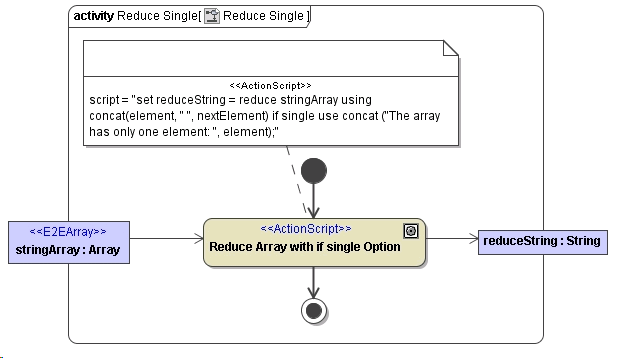|
Syntax |
|
|
|---|---|---|
|
Semantics |
If the array exists, but has no array elements, an exception is raised: " |
|
|
Substitutables |
|
Can be any variable or object attribute having the type Array. |
|
|
This expression must use the currently evaluated array element and its next neighbor and evaluates to a scalar having the same type as the result value. |
|
|
|
The expression after |
|
|
Examples |
|
|
Reducing Arrays with Elements of Base Type
For example, in an array of strings, you can reduce the list to a simple string consisting of a concatenation of all single elements. Suppose you have an array of Strings and you wish to copy all of them to a single String, separated by a space. The solution is to use operation reduce in combination with using concat(element, " ", nextElement). Note that the second parameter of the concat operation is the string that should be used as separator between any given array element and its next neighbor. In this case, this is a space string literal.
The example below will concatenate all elements of a string array together with "space slash space" as a separator between any two elements.
set value = reduce myList using concat(element, " / ", nextElement) if single use element;
element and nextElement are keywords and allow you to use relative references (as opposed to normal, absolute indexes) to single elements of an array (see Get Array Element).
Based on the type of the array elements, you may use different operations. For example, elements of base type Integer can be computed (addition, subtraction, division, or multiplication).
set sum = reduce myNumbers using element + nextElement if single use element;
Reduce Algorithm
The reduce algorithm works as follows. Suppose you want to reduce the array myNumbers having the numbers 1, 2, and 3. In the first iteration, the first occurrence of the element expression is initialized (here: take the first integer 1), then the next element is evaluated and added (+ nextElement). The result of the first iteration is 3. In the second iteration, element refers to the intermediate result of the first iteration. Then, nextElement is added again, resulting in value 6. This value is finally assigned to integer sum.
The following activity diagram shows how to reduce strings and integers to a scalar.
Figure: Reducing Arrays with Elements of Base Type

Reducing Arrays with Elements of Complex Type
The same algorithm applies to arrays with elements of complex types as described in the previous chapter. Since each element or nextElement refers to an object of complex type, you can access the attributes of the object like any other instance (e.g. element.name).
In the example below, array inArray contains objects of complex type ReduceStructure. Now, you wish to copy attribute strAttr of each array element to a single string separated by a semicolon using the operation reduce in combination with using concat(element, ";", nextElement).
set outString = reduce inArray using concat(element.stringAttr, ";", nextElement.stringAttr) if single use element.stringAttr;
Figure: Reducing Arrays with Elements of Complex Type

Single Array Elements
If an array contains only one single element, you can define what will be assigned to the scalar with the mandatory extension if single use in the reduce statement.
Figure: Reducing an Array Having a Single Element

If an array has only one single element, the statement following if single use will be evaluated. In the example above, element refers to the only string in the array. If the string is Hello World!, the string The array has only one element: Hello World! will be assigned to the output string reduceString.
In the following example, the square of an integer contained in the array will be returned, if the integer is the only element in the array. Otherwise, all integers of the array will be multiplied with each other and assigned to outInteger.
set outInteger = reduce inArray using element.intAttr * nextElement.intAttr
if single use element.intAttr * element.intAttr;
